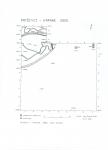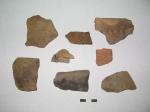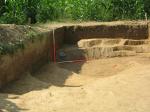Summary (English)
From June 20th to July 18th, 2005, the Križevci Municipal Museum conducted systematic archaeological research at the Križevci – Karane site, at the Belavina location. The excavated area of 78 m² was covered by two trenches.
The cultural layer appeared at a depth of 35 cm. One sunken-floored building, SJ 3, was explored, however it was not fully defined because it ran into the western and eastern profile of the trench, but the part of the pit covered by the excavation could also not be fully explored because the pit was intersected by a trench with underground VN cables in the eastern part. The dimensions of the excavated part of the building are 4.90 × 3.50 m. In the southern part of the pit, two higher plateaus stand out. The bottom of the shallower one, located along the southern edge of the pit, is at a depth of 0.20 m from the level of observation, while the bottom of the deeper plateau, located just north of the shallower, is at a depth of 0.40 m from the level of observation. The bottom of the pit is at a depth of 0.65 m, measured from the level of observation. The northern part of the building ended with stairs, i.e. benches arranged in two levels. The bench built on a higher level is much more spacious, and it was discovered at a depth of 0.20 m from the level of observation. Two smaller steps of the lower level were discovered at a depth of 0.45 and 0.50 m, from the level of observation.
In the north-western corner of the trench, an elevated platform with a bottom at a depth of 0.20 m stands out, that emerges from the excavated area to the north and west. To the east of the SJ 3, two larger clusters of daub were discovered, SJ 4 and SJ 5. Fragments of pottery were most common among the found material. Part of the pottery material belongs to the Middle Neolithic Lasinja culture, while part of the pottery is associated with the Late Neolithic period, and a fragment of the Korenovo culture of the Middle Neolithic was collected. Pottery fragments of the Lasinja culture were collected on the surface layer and in the SJ 3, mixed with earlier pottery. The shapes are biconical bowls with a convex upper cone, rounded bowls, pots, jugs with a handle and spoons with a sleeve for planting a wooden handle. The decoration is done with tongue-shaped plastic applications, stabbing, incisions and shallow grooves. Pottery of the late Neolithic horizon is represented by pots and pots with a handle under the rim, biconical and rounded bowls, and cups. It is decorated with fingerprints and nails in a horizontal row, by digging and grooving. It reflects the influences of late Lengyel cultures, as well as classical Sopot culture, and is classified in the Pepelana type of Sopot culture.
Numerous lithic material was also found and collected. The most frequent stone artefacts are scrapers and blades, made by chipping technique, and the cores from which they were split. Polished stone tools are represented by pointed axes, hammer axes with holes and hoes.
During the excavations, a sunken-floored building of the late Neolithic period was explored, which was later inhabited by the bearers of the Lasinja culture. A fragment of the Korenovo culture indicates that the site dates from the Middle Neolithic period. After the completion of the excavation, the site was returned to its original condition (L. Okroša Rožić 2006, Hrvatski arheološki godišnjak 2/2005, 110–112).
- Lana Okroša Rožić
Director
- Lana Okroša Rožić
Team
Research Body
- Gradski muzej Križevci
Funding Body
- Koprivničko-križevačka županija
- Ministarstvo kulture Republike Hrvatske






![Download [PDF]](/excavation/skins/fasti/images/results/download_sml.png)

